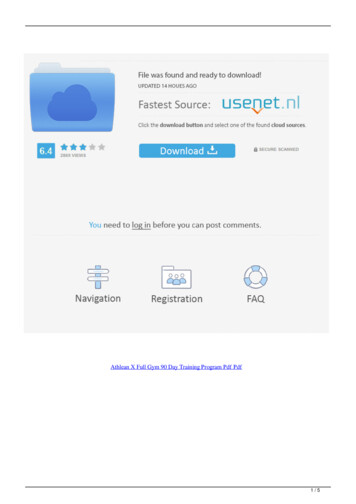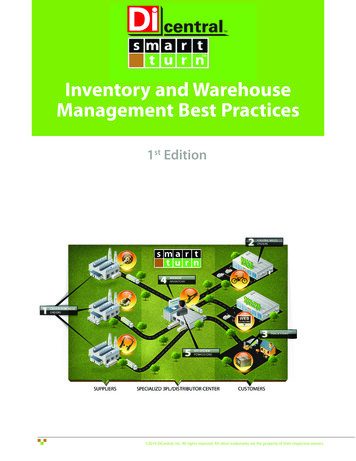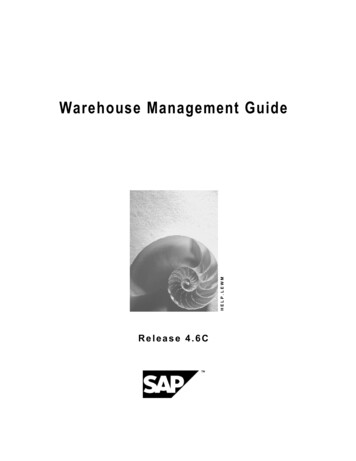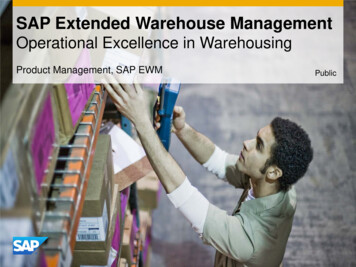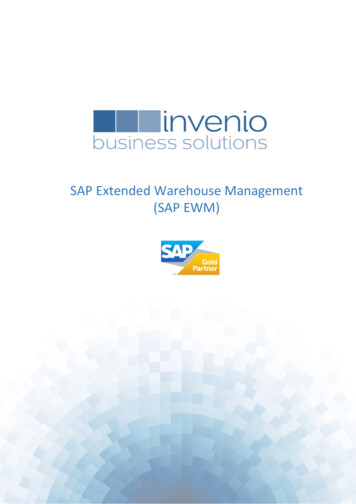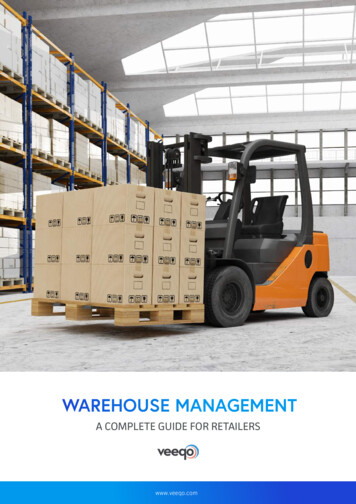
Transcription
WAREHOUSE MANAGEMENTA COMPLETE GUIDE FOR RETAILERSwww.veeqo.com
CONTENTS1. What is warehouse management? 022. Warehouse Management Statistics 033. Arranging your warehouse 04General warehouse layout 04Labelling areas of your warehouse 05How to arrange inventory in the warehouse 074. Receiving and managaing new stock 095. Warehouse management fulfilment strategies 10Choosing an optimal picking system 11Optimising your packing process 12Shipping your orders 146. Measuring warehouse performance 14Receiving efficiency 15Rate of return 15Picking accuracy 15Order lead time 157. Choosing a Warehouse Management System 16When to upgrade to a Warehouse Management System 17What to look for in a Warehouse Management System 188. In summary 19Warehouse Management: A Complete Guide for Retailers
INTRODUCTIONA solid warehouse operation is at the foundation of every successfulretail brand. It’s an area that could either destroy your business. Orpropel it into something customers trust time and time again.But getting it right is no simple task. That’s why we put together thiscomplete guide to warehouse management. We cover everything neededto run your warehouse like clockwork – from how to arrange it, to bestpicking and packing processes and even choosing an effective WarehouseManagement System.BigCommerce’s Omnichannel Retail Report found that:80% of respondents ranked shipping cost and speed to be “extremelyinfluential” in where they shopped. With price being deemed the onlypurchasing factor more persuasive.Meaning the need for effective warehouse management is more importantthan ever.Click here to view this blog post on our website01 Warehouse Management: A Complete Guide for Retailers80% ofshoppersrankshippingcost andspeed to be“extremelyinfluential” inwhere theypurchase.
WHAT IS WAREHOUSE MANAGEMENT?Warehouse management is the act of organising and controlling everythingwithin your warehouse – and making sure it all runs in the most optimal waypossible.This includes: Arranging the warehouse and its inventory. Having and maintaining the appropriate equipment. Managing new stock coming into the facility. Picking, packing and shipping orders. Tracking and improving overall warehouse performance. Most high growth retailers would use automation tools (like some form of.Warehouse Management System) to control this part of their supply chain.However, there are many aspects that can and need to be considered from amanual standpoint. And so we cover this entirely in this guide.02 Warehouse Management: A Complete Guide for RetailersWarehousemanagementmeansmakingsure yourwarehouseoperationsrun inthe mostoptimal waypossible.
WAREHOUSE MANAGEMENT STATISTICSAccording to MetaPack’s 2015 State of Ecommerce Delivery Report, 66% ofshoppers bought goods from one retailer in preference to another because thedelivery services on offer were more appealing.And 96% of the same shoppers said a positivedelivery experience would encourage them to shopwith a retailer again.And Volume Five of that same report claims that 63% say delivery speed is important whensearching for and selecting products, with 77% willing to pay for expedited shipping.The UPS Pulse of the Online Shopper 2017 reports that 44% ofconsumers say speed of delivery is a reason they choose to shop atTemando’s 2017 State of Shipping in Commerce Report claims that 54% of UK shopperswould buy from a competitor when the delivery service they seek isn’t provided – 10% morethan US buyers.03 Warehouse Management: A Complete Guide for Retailers
ARRANGING YOUR WAREHOUSEProbably the most important first step in optimising your warehouseoperations is making sure you have everything in there arranged in the mostefficient way. Here’s what you need to think about:GENERAL WAREHOUSE LAYOUTPlanning the layout of your warehouse is centred on balancing two things:Providing enough storage space for your inventory; While still having enoughworking space for staff to move around and complete their tasks. And thisgenerally requires (although it depends on individual business requirements)having a space designed to house the following areas:Receivingnew stockareaUnpacking/booking innew stockareaPackingareaShippingstationExcess/dead A warehouseofficestocking areaA mainstorage areaThis can be tricky – especially when dealing with a limited space. So it’sbest to sketch out your warehouse layout to scale before setting it up orchanging what you already have.Using a grid system makes planning this a lot easier. Space andmanoeuvrability is a key thing to remember. Pickers need to be able towalk up and down aisles without getting in each other’s way. And shouldalso have enough room to actually pick items.04 Warehouse Management: A Complete Guide for RetailersWarehouselayoutshould bebalanced onprovidingenoughstoragespace andworkingspace forstaff.
LABELLING AREAS OF YOUR WAREHOUSEEffective warehouse management can’t be done without set locationnames for stock that have been clearly labelled. Your team should be ableto look at your warehouse system and see exactly where any product islocated.Practicality is king here. Sticking with simple alphanumeric combinationsmakes it easier to understand and decipher for pickers trying to reachthat site location. For example, you can start by simply including labelsfor specific rows, shelves and then exact bin locations:So you always know, forexample, that all your bluet-shirts sized medium willbe in Row A – Shelf B – Bin1. And the pattern can becontinued like this.05 Warehouse Management: A Complete Guide for RetailersStickingwith simplealphanumericcombinationsmakes iteasier forpickers tounderstandthe location.
Bigger warehouses with more rows may need to add a little more detail:And then even larger warehouses may even need to be split up intodifferent areas for each row and the facility as a whole:How detailed you go with labelling depends totally on the size of yourfacility or site, complexity of your warehouse operations and a rangeof other factors. But in short: The bigger your facility, the more indepth you’ll need to go with your location labelling to achieve optimalwarehouse management.06 Warehouse Management: A Complete Guide for RetailersHow detailedyou go withlabellingdepends onthe size andcomplexity ofwarehouseoperations.
HOW TO ARRANGE INVENTORY IN THE WAREHOUSESo at this point we have a warehouse that’s laid out and labelledin the most optimal way for your business. But this now raises thequestion: How do you determine the exact location each productshould be stored? The answer: Keep better selling products closer tothe packing desk.Research we conducted on over 20 Veeqo retailers found that 60%of a company’s sales tend to come from just 20% of their products.Meaning you can severely reduce picker walking time by Identifyingthat 20% of products from past sales data in your business; andthen storing these as close to the packing desk as possible. Toolslike ABC Analysis tend to be used more in inventory management.But this can provide some handy information when it comes to thispart of warehouse management too. Divide all on-hand inventoryinto three groups – A, B and C:A Items: Are of high value with low sales frequency.B Items: Are of moderate value with moderate salesfrequency.C Items: Are of low value with high sales frequency.You can then decide that ‘C items’ will be placed closest to thepacking desk, while ‘A items’ will be farthest away. Like this:07 Warehouse Management: A Complete Guide for Retailers60% of acompany’ssales tendto comefrom just20% of theirproducts.
Some small and lightweight items may even be sold frequently enough towarrant being stored on shelves above the packing desks themselves. Thismeans packers can quickly add these into relevant orders and pickers canfocus on bigger items. Finally, you can take this concept another layer deep byalso identifying which products are most commonly sold together. So fasterselling products are stored closer to the packing desk and products commonlypurchased together are stored close or next to each other. Meaning you’redoubling down on reducing walking time for each picker.DON’T BE AFRAID TO REARRANGEA small final point in this warehouse management section is this: Don’t beafraid to rearrange your warehouse. Yes – it can take time and resources toimplement and may seem like more hassle than it’s worth. But an optimallyarranged warehouse can save bags of time overall and severely reducecosts for entirety of your supply chain management. While inefficienciescan seriously hamper growth. So regularly evaluate and – if necessary– rearrange or upgrade. For example, it may be that your best sellingproducts in summer become your worst selling come winter, and vice versa.Or you sell more of specific products on Valentine’s Day or other key retaildates through the year. So it makes sense to rearrange these products inline with this when the time comes – moving some closer to the packingdesks and others farther away.08 Warehouse Management: A Complete Guide for RetailersAn optimallyarrangedwarehousecan save bagsof time overalland severelyreduce costs.
Have appropriate spaceRECEIVING AND MANAGING NEW STOCKThere needs to be enough space in yourreceiving area to both temporarily housenewly delivered stock without risk of damageStock doesn’t just appear out of nowhere. And so a critical part ofwarehouse management is being able to receive, unpack, put awayand for your team to perform the necessarytasks with it.and book in new inventory as efficiently as possible. The faster thisRecord everythinghappens, the sooner that stock becomes available for sale.It’s a good idea to record relevant details tofall back on if there are any problems – e.g.exact timestamps of when new stock arrivesAnd what’s more, any errors or inefficiencies in this process will thencascade through the remainder of the entire supply chain. Here’s whatyou need to consider:and is put away.Have assigned workersNew stock needs to be dealt with as soon aspossible – not left to build up. Make sure it’sRECEIVING VIA DIGITAL MOBILE SCANNERclearly communicated whose job it is to dothis.It’s worth noting that a mobile scanner device can make this wholePut awaybooking in process much quicker and more accurate.Add any necessary labelling or barcodesbefore physically putting the stock away tobe stored in its relevant warehouse place.Rather than needing to sit at a computer and individually find and updateeach product, you’d simply:Inspect carefullyDedicate some time and resources to1. Scan a product or purchase order2. Update inventory levels on the mobille screen - making the invenotryavailable for saleensuring all new deliveries are correct innumber and free of damage. This is a greatopportunity to identify any vendor, inboundshipping or packaging problems.3. Put it away in the warehouse - making it a much easier and quickerprocessUpdate inventoryMake sure all the stock levels are correctlyupdated on each sales channel or inventorymanagement system – meaning it’s live andready for purchase.09 Warehouse Management: A Complete Guide for Retailers
WAREHOUSE MANAGEMENT FUFILMENTSTRATEGIESBeing able to fulfil orders quickly and accurately is an absolute staple of goodwarehouse management. After all, it’s pretty much the entire reason for thewarehouse existing in the first place. Here’s what you need to think aboutwhen it comes to picking, packing, shipping and your distribution strategy ingeneral:Picking may seem like a simple concept at first. And it is – when you only havea few orders to deal with. But this becomes a much different story once you’redealing with hundreds (or even thousands) of multiple item orders each day.In fact:Research we recently conducted on 20 Veeqo retailers found that 70% oflabour time when processing an order is spent on just picking the products.And 60% of a picker’s time is taken up by simply walking around thewarehouse.So getting a solid picking system in place can have a major impact on overalldistribution productivity.SEE ALSO: Warehouse Order Picking Systems: Everything You Need to Know10 Warehouse Management: A Complete Guide for Retailers70% oflabourtime whenprocessingan order isspent on justpicking theproducts.
These are the four main picking systems or methods used by medium to large retailers:Single orderThis is the most basic picking method – typically only used by those just starting out. Quite simply, a picker will pick one orderat a time in its entirety before moving on to the next.Best for: Retailers just starting out who aren’t yet big enough to gain the benefits of more complex picking methods.Avoid if: You ship more than 20 customer orders a day (or plan to in the near future).Batch pickingThe picker is assigned a batch consisting of a number of orders, picks them all in one go and then returns to a packing desk.The picker will then get assigned a new batch to pick. The number of orders allocated to each batch is generally between 10and 30. But this really depends on the physical size of your products and average order size.Best for: High number of orders with single or low number of products per order.Avoid if: You have a high number of products per order (or are aiming for this in the near future).Zone pickingThis sees each picker assigned their own area (or zone) of the warehouse with them only picking products stored in thatspecific zone. An order is passed through all areas to have any required items added to it by pickers in that zone before beingreturned to a packing desk.Great for preventing multiple pickers getting in each other’s way, but it can also create a slightdelay in shipping as each order needs to be passed around the warehouse.Best for: Retailers typically shipping a high volume of multiple item orders.Avoid if: You typically ship single or low item orders or have very few pickers.Wave pickingSimilar to zone, but all zones pick at the same t
Warehouse management is the act of organising and controlling everything within your warehouse – and making sure it all runs in the most optimal way possible. This includes: Arranging the warehouse and its inventory. Having and maintaining the appropriate equipment. Managing new stock coming into the facility. Picking, packing and shipping orders. Tracking and improving .



